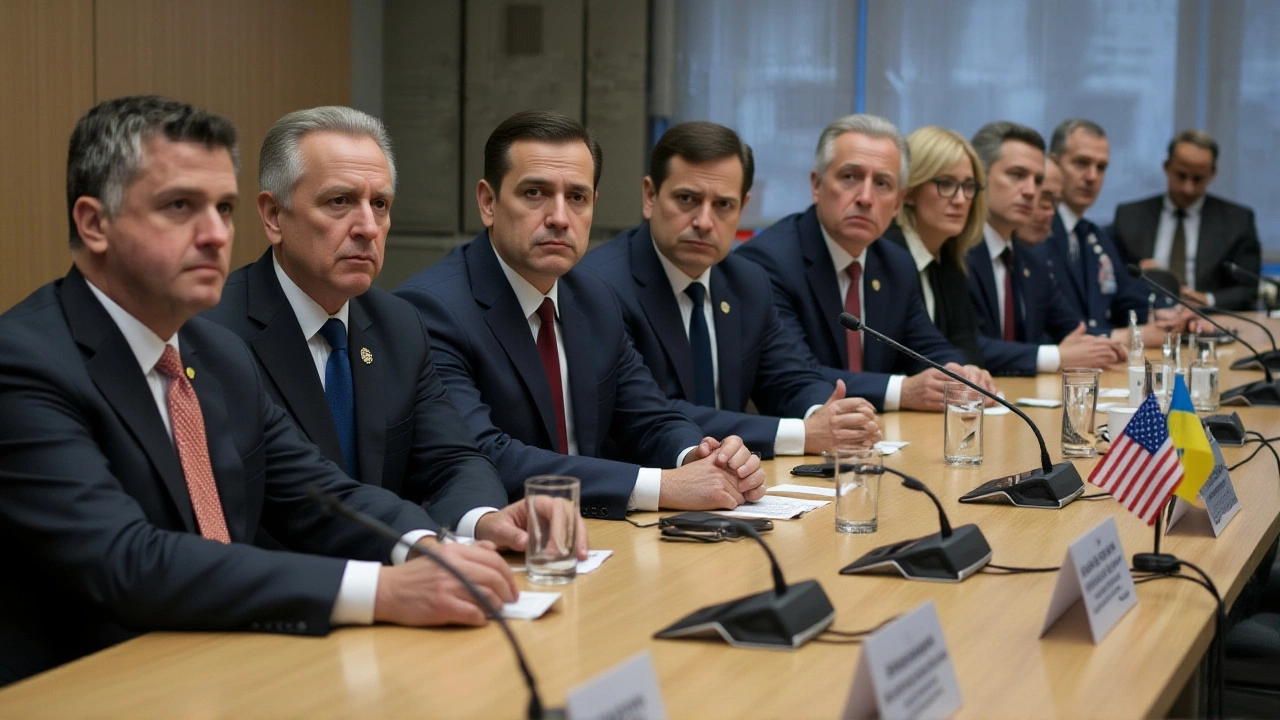On Sunday, November 23, 2025, U.S. and Ukrainian officials walked out of a tense, 12-hour negotiation in Geneva with something rare in this war: momentum. After months of stalled diplomacy, they announced a breakthrough on President Donald J. Trump’s 28-point peace proposal — a plan that demands Ukraine surrender territory, abandon NATO aspirations, and pardon Russians accused of war crimes. The deal, described by a U.S. official as "the best day we have had in our entire 10 months of working on these issues," marks a dramatic pivot in Washington’s approach to the war — and a gut-wrenching compromise for Kyiv.
What’s in the Plan? The Hard Choices
The proposal, first detailed by Axios on November 18, 2025, hinges on three non-negotiable U.S. demands: Ukraine must formally cede control of occupied areas in the Donbas and Crimea; commit to never seeking NATO membership; and issue blanket amnesty to Russian military personnel accused of atrocities. In return, Washington promises a binding security guarantee — including U.S. troops on Ukrainian soil, long-term military aid, and infrastructure rebuilding funds worth an estimated $2.3 billion over five years. Ukrainian officials told reporters the security package "meets our essential strategic needs," even as lawmakers in Washington recoiled. "I would not advise Ukraine to sign this," said Senator Tammy Duckworth (D-IL) on CNN. "That plan. That is Putin’s plan. That is a very good deal for Russia." The White House statement, released late Sunday, claimed Ukraine’s "primary concerns — security guarantees, long-term economic growth, infrastructure protection, and sovereignty — were comprehensively addressed." But the phrase "freedom of" in that sentence was left hanging, a telling sign of rushed drafting. The document also contained a grammatical error: "Final determinations within framework will made by Presidents of [Ukraine] and the United States." It’s unclear whether this reflects a translation issue, a typo, or the chaotic pace of negotiations.The Players: Who Sat at the Table?
The U.S. delegation was led by Secretary of State Marco Antonio Rubio, joined by House Special Envoy Steve Biegun (correcting the White House’s "Stevekoff" error), Army Secretary Dan Driscoll, and Jared Corey Kushner, Trump’s son-in-law and senior adviser. The Ukrainian side included Foreign Minister Dmytro Kuleba and National Security Advisor Oleksiy Danilov. The talks took place at the U.S. Mission in Geneva, a neutral ground chosen to avoid the optics of a summit in Washington or Kyiv. According to a U.S. official familiar with the discussions, the atmosphere was "intense but constructive," with Ukrainian negotiators pressing for clearer language on troop deployment timelines and audit mechanisms for the aid package.Pressure Tactics and the Thanksgiving Deadline
Behind closed doors, the U.S. reportedly delivered an ultimatum: Agree to the framework by Thanksgiving — Thursday, November 27, 2025 — or face an immediate halt to all military aid and intelligence sharing. Secretary Rubio publicly downplayed the deadline, telling reporters, "We’re focused on getting it right, not on a calendar." But WHAS11’s source confirmed the threat was real — and it’s not the first time. Back in February 2025, Keith Matthew Kellogg, Trump’s Special Envoy for Ukraine and Russia, hinted at the plan’s contours at the Munich Security ConferenceMunich, where he posted on X: "I look forward to speaking about [Donald Trump]’s goal to end the bloody and costly war in Ukraine." Bloomberg reported at the time that the plan would freeze the frontlines — effectively rewarding Russian occupation.
Why Ukraine Might Say Yes
It’s counterintuitive, but Kyiv’s calculus has shifted. After two years of attrition, Ukrainian forces are stretched thin. Winter is coming. Western aid has stalled in Congress. And Moscow, though battered, still holds 18% of Ukrainian territory. Ukrainian officials say the U.S. security guarantee — with its promise of permanent U.S. bases, air defense systems, and rapid-response units — offers more tangible protection than the vague assurances of NATO membership, which remains politically impossible in Washington. "We have never wanted this war," said President Volodymyr Oleksandrovych Zelenskyy on Sunday. "And we will never be an obstacle to peace." But he didn’t say "yes." He said "we are listening." Meanwhile, on the ground, the fighting didn’t stop. Over the weekend of November 22–23, Russian artillery struck Kharkiv and Donetsk, killing 17 civilians — a grim reminder that peace talks don’t pause bullets.What Comes Next? Russia’s Role
The White House confirmed plans for a separate meeting with Russian officials — though no location, date, or delegation has been announced. Kremlin spokesperson Dmitry Sergeyevich Peskov has signaled Moscow’s willingness to negotiate, but only if Kyiv accepts the "new realities on the ground" — a diplomatic euphemism for permanent Russian annexation. The U.S. hopes to use its leverage with Ukraine to pressure Moscow into a deal. But experts warn this could backfire. "You can’t negotiate peace with a party that’s still winning," said Dr. Elena Sokolova, a senior fellow at the Carnegie Endowment. "If Russia believes the U.S. is abandoning Ukraine, they’ll dig in deeper."
The Broader Fallout
European allies are furious. French President Emmanuel Macron called the proposal "a betrayal of the principles we’ve defended since 2014." Germany has frozen new arms shipments pending a review. NATO’s Secretary General, Jens Stoltenberg, issued a rare public rebuke: "The alliance stands by Ukraine’s sovereignty — not by U.S. bilateral deals." Inside the U.S., the divide is stark. Republican lawmakers like Senator Tom Cotton praised the plan as "realistic," while Democrats in the House have vowed to block funding if the deal is signed. The White House, however, insists it’s a "sovereign decision for Ukraine," even as it privately pressures Kyiv with the threat of aid cuts.What’s at Stake?
This isn’t just about territory. It’s about the future of international law. If Ukraine is forced to surrender land under threat of abandonment, it sets a precedent that could embolden China, Iran, and others to use force to redraw borders. It also risks fracturing the Western alliance — and handing Putin a victory he couldn’t achieve on the battlefield.Frequently Asked Questions
What exactly does Ukraine have to give up in Trump’s peace plan?
Ukraine would have to formally relinquish control of all territories currently occupied by Russia since 2014 — including Crimea and large parts of Donetsk and Luhansk. It must also legally pledge never to join NATO, and grant amnesty to Russian soldiers accused of war crimes, even those indicted by the ICC. In exchange, the U.S. offers a binding security guarantee with permanent military bases and $2.3 billion in aid.
Why would Ukraine accept a deal that gives up land?
With Western aid slowing and Russian forces still advancing, Ukrainian leaders believe the U.S. security guarantee — including U.S. troops on their soil — offers more immediate protection than the uncertain promise of future NATO membership. They also fear a complete cutoff of military support if they refuse, which could lead to total collapse.
Is the November 27 deadline real, or just pressure?
Multiple U.S. officials confirm the deadline is real. While Secretary Rubio publicly downplayed it, WHAS11 reported the administration threatened to halt all military aid and intelligence sharing if no agreement is reached by Thanksgiving. This isn’t the first time Trump’s team has used aid as leverage — similar tactics were used in 2023 during the F-16 delivery delays.
How has Europe reacted to this deal?
European allies are deeply alarmed. France and Germany have paused new arms deliveries, while NATO’s leadership issued a rare public warning that bilateral deals cannot override alliance principles. Many fear this deal undermines the collective security framework that’s held since 2014 — and signals to Moscow that the West will eventually cave.
What happens if Ukraine refuses the deal?
U.S. military aid — including Patriot missiles, F-16s, and intelligence coordination — would likely be frozen. The White House has signaled it would shift focus to diplomatic isolation of Russia, but without U.S. backing, Ukraine’s ability to defend itself could collapse within months. Some analysts warn this could trigger a full-scale Russian offensive in early 2026.
Has Russia agreed to any terms yet?
No formal agreement has been reached. The U.S. has confirmed plans to meet with Russian officials soon, but no details have been released. Moscow has only stated it’s "ready for negotiations" and insists Ukraine must accept the "new realities on the ground" — meaning permanent Russian control of occupied territories. So far, Russia has not budged on its core demands.



